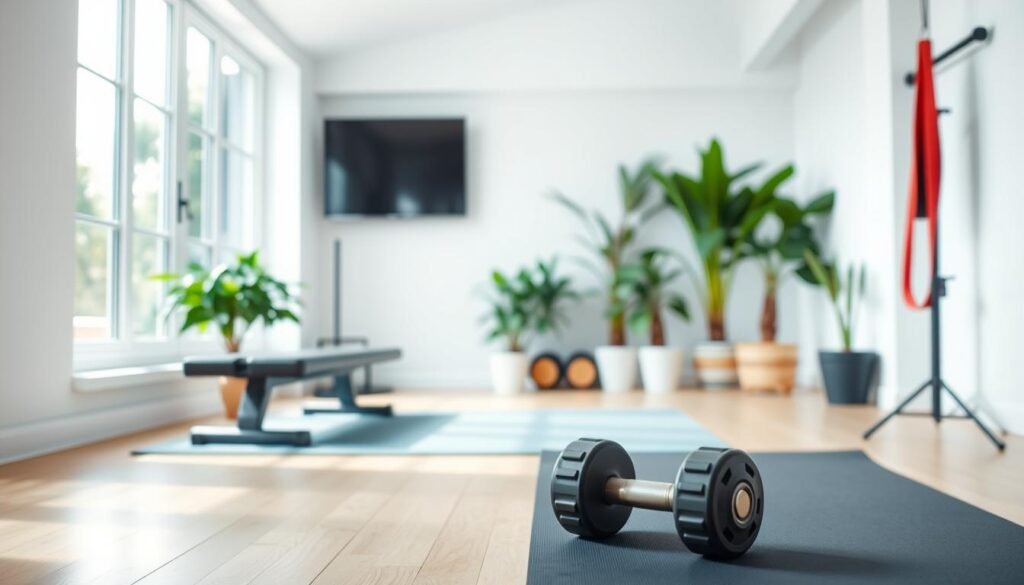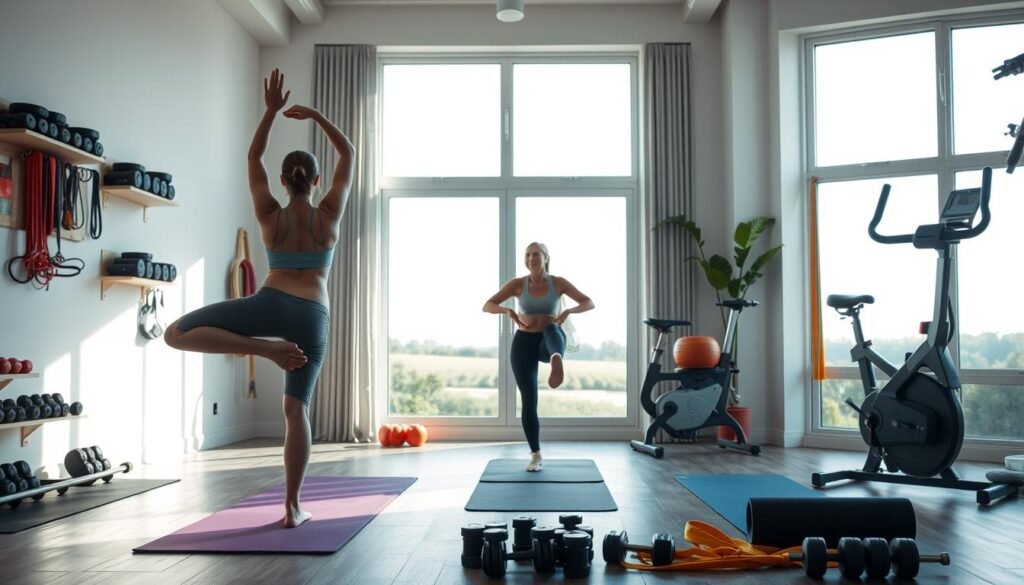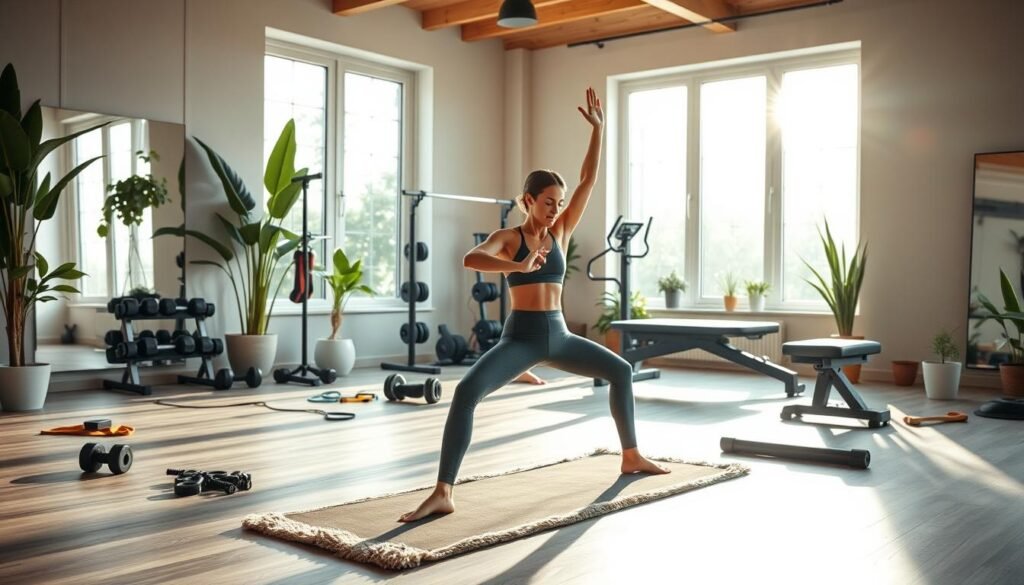Ever wondered how small changes in your daily routine can transform your health? With busy schedules and limited time, finding ways to stay active at home has never been more important. The CDC recommends at least 150 minutes of moderate activity per week, but many struggle to fit it in.
Good news—you don’t need a gym membership to stay fit. Simple adjustments, like short workouts or active breaks, can make a big difference. The American Heart Association suggests balancing aerobic exercise with strength training for optimal results.
This guide will help you build sustainable habits. Whether you have 10 minutes or an hour, you’ll find easy ways to boost your energy and well-being.
Key Takeaways
- Home workouts save time and fit into busy schedules.
- CDC advises 150+ minutes of weekly activity for health benefits.
- Mix cardio and strength training for balanced fitness.
- Small daily changes lead to long-term improvements.
- No gym? No problem—bodyweight exercises work anywhere.
Why Improving Physical Fitness Matters
The power of staying active extends far beyond weight management. Every movement strengthens your body and fuels your health, offering rewards that start immediately and last a lifetime.

Feel Better Today
Exercise triggers endorphins within 10 minutes, lifting mood and reducing stress. Studies show active adults sleep deeper and report 30% lower anxiety levels, according to the CDC.
Even modest activity, like brisk walking, can lower blood pressure. These benefits make daily tasks easier and boost energy without drastic lifestyle changes.
Protect Your Future
Regular movement slashes risks for chronic conditions. The AHA notes a 40% drop in colon cancer risk and 50% lower dementia odds for active individuals.
Your heart thrives too—consistent activity raises HDL cholesterol and cuts type 2 diabetes risk by half. Just 150 weekly minutes reduces early mortality by 31%, per HHS data.
From sharper minds to stronger immunity, investing in movement today pays dividends for decades. It’s the simplest disease prevention tool you own.
Steps to Improve Physical Fitness: Getting Started
Starting your journey toward better health doesn’t require drastic changes—just smart planning. The CDC’s 150 minutes weekly goal may seem daunting, but breaking it into smaller chunks makes it manageable. For example, 30 minutes a day for 5 days or three 50-minute sessions fit seamlessly into most schedules.

Set Realistic Weekly Goals
Track your progress with an activity diary to identify free time slots. NASA research shows even 8-minute high-intensity workouts can boost endurance. Try splitting sessions—like 10-minute yoga, a 15-minute walk, and 5-minute stretches—to meet daily targets.
Incorporate Movement Into Daily Routines
Set phone alarms for movement breaks every 90 minutes. Household tasks count too: stair climbing or laundry basket squats add up. These small bursts of physical activity improve circulation and energy levels.
Choose Activities You Enjoy
Variety prevents boredom. Test three exercise types in two weeks—dancing, cycling, or bodyweight circuits. Enjoyment increases adherence, turning fitness from a chore into a rewarding habit.
Effective At-Home Exercises for All Levels
No equipment? No problem—effective workouts await right in your home. Whether you’re a beginner or seasoned mover, these routines align with physical activity guidelines and adapt to any space. Focus on three key types: cardio, strength, and balance.

Moderate-Intensity Aerobic Activities
Get your heart pumping with simple activities. Brisk walking (2.5+ mph) counts, per the AHA. Try marching in place during TV ads or climbing stairs for 5-minute bursts.
Compare calorie burns: 10 minutes of jumping jacks torches 100 calories, while dance workouts zap 80. Both boost endurance at moderate intensity.
Bodyweight Strength Training
Build muscle using your body as resistance. A sample circuit: push-ups, chair dips, and plank holds. Progress by slowing reps or adding pulses.
No bands? Fold a towel for rows. Seated leg lifts work for limited mobility. Strength exercise preserves bone density and metabolism.
Flexibility and Balance Routines
Prevent falls with CDC-recommended moves. Stand on one leg while brushing teeth or walk heel-to-toe. Yoga poses like tree pose enhance stability.
Stretch daily—try seated toe touches or shoulder rolls. Flexibility supports joint health and reduces injury risks.
Creating a Sustainable Home Workout Routine
A successful home workout routine thrives on consistency, not complexity. The CDC’s Move Your Way Activity Planner shows that small, scheduled efforts yield lasting results. With 75% of regular exercisers treating workouts like appointments (AHA survey), structure is key.

Schedule Like a Pro
Plan 3–5 days per week based on your energy peaks. Early birds might opt for sunrise yoga, while night owls prefer post-dinner dance sessions. NASA’s 20-minute full-body sequence fits packed schedules.
Keep It Fresh
Mix cardio and strength activities to avoid burnout. Try “Mobility Monday” with stretches or “Cardio Wednesday” with jump rope. DIY workout dice (roll for squats, lunges, or planks) add playful variety.
Measure What Matters
Track progress beyond the scale. Note sleep quality, mood shifts, or how clothes fit. Apps or wall calendars help visualize wins. Habit stacking—like squats during coffee brewing—builds consistency effortlessly.
Overcoming Common Fitness Obstacles
Breaking through fitness barriers starts with smart solutions. Whether it’s a packed schedule or limited room, small adjustments keep you on track. The CDC reports that 68% of home exercisers use virtual classes—proof that flexibility wins.
Time Management Strategies
Short on time? The CDC’s DeskFit program proves 10-minute office workouts work. “Exercise snacks”—5-minute bursts like stair climbs or wall sits—add up to 30+ weekly minutes.
Calculate savings: skipping gym commutes frees up 100+ hours yearly. Slot workouts into TV time or morning routines. Every minute counts.
Staying Motivated Without a Gym
Virtual buddies help. Join Fitbit challenges or stream live classes for accountability. The AHA found social exercisers stick to goals 40% longer.
Mix it up: try “no-equipment” days with lunges or shadowboxing. Track non-scale wins like better sleep or mood boosts.
Adapting Workouts for Limited Space
Tight on space? Modify HIIT moves—swap jumping jacks for step taps. Use chairs for triceps dips or towels for sliding mountain climbers.
Prevent falls with balance drills: heel-to-toe walks or single-leg stands. Even a 3×3 ft area works for yoga flows or resistance bands.
Warm-ups matter: dynamic stretches (arm circles, knee lifts) cut injury risks by 50%. Adapt for age or mobility—seated marches count too.
Family-Friendly Fitness Strategies
Kids naturally love movement—harness that energy for family fitness wins. SmallStep.gov suggests simple activities like after-dinner walks or taking the stairs together. These small changes build healthy habits while keeping everyone engaged.
Active Play With Kids
Turn playtime into workouts. Animal walks (bear crawls, frog jumps) and DIY obstacle courses burn energy and build coordination. A 30-minute playground visit torches 150+ calories—more if parents join in.
Household Chores as Exercise
Mopping floors for 30 minutes burns 153 calories—add squats while folding laundry. Make it a game: race to tidy rooms or see who can do the most lunges while vacuuming.
Creating Fitness Traditions
Start weekend dance parties or step competitions using free tracker apps. Grandparents can lead seated yoga sessions, making fitness intergenerational. Consistency turns these activities into cherished routines.
Safety Tips for Home Workouts
Staying safe during home workouts ensures long-term progress and prevents setbacks. The CDC’s guidelines emphasize proper preparation to avoid injury and maximize health benefits. Whether you’re new to exercise or adapting routines for conditions, these strategies keep you moving confidently.
Proper Warm-Up and Cool-Down
Begin with a 5-stage warm-up: light cardio (marching), dynamic stretches (leg swings), mobility drills (arm circles), muscle activation (glute bridges), and sport-specific moves (shadowboxing). This reduces strain by increasing blood flow.
Cooling down is equally vital. Try static stretches held for 15–30 seconds, like hamstring reaches or chest openers. The AHA notes this lowers heart rate gradually and prevents dizziness.
Listening to Your Body’s Signals
Use the perceived exertion scale (1–10) to gauge intensity. Aim for 5–6 during moderate activity. Sharp pain, dizziness, or nausea are red flags—stop immediately.
Adapt for age or fitness level. The AHA’s target heart rate zones suggest 50–85% of your max (220 minus your age). A fitness tracker helps monitor this.
Adapting for Injuries or Conditions
For joint issues, swap jumps for step-ups or use chairs for support. The CDC’s RICE method (Rest, Ice, Compression, Elevation) treats minor sprains.
Telehealth platforms offer form checks. Seek medical advice if pain persists beyond 48 hours or limits daily movement.
Resources to Support Your Fitness Journey
Building lasting fitness habits is easier with the right tools and support. From free apps to community programs, these resources help you stay consistent and informed. Whether you’re tracking progress or seeking expert advice, the right information keeps you motivated.
Free Apps and Online Tools
Nike Training Club offers 100+ workouts, from yoga to HIIT, with no cost. MyFitnessPal tracks nutrition and activity, syncing with most devices.
YouTube channels like Fitness Blender provide free routines by certified trainers. Libraries often carry workout DVDs—check your local branch’s catalog.
Community Support Options
Join the CDC’s Active People, Healthy Nation initiative for group challenges. YMCA’s virtual classes connect you with live instructors.
Medicare’s SilverSneakers program includes gym access and online workouts. Park districts host walking clubs—perfect for social exercisers.
Trusted Fitness Guidelines
Explore the Move Your Way plan from the HHS for personalized activity tips. The NIH’s Exercise Toolkit breaks down workouts by skill level.
Bookmark the CDC’s DeskFit page for office-friendly moves. Always verify sources—look for .gov or .edu domains for reliable guidelines.
Conclusion: Your Path to Better Health Starts Today
Small actions today create lasting benefits for your life and well-being. Just 150 minutes of activity weekly cuts early mortality risk by 31%—proving every minute counts.
Remember: five minutes of movement beats zero. A 60-year-old transformed her health with daily stair climbs and living-room yoga. You can too.
Get active now—take the stairs tomorrow or try a 10-minute workout. Need guidance? Call the National Exercise Helpline at 1-800-123-4567.
Your stronger, healthier future begins when you start today.
FAQ
How much activity do adults need each week?
The Department of Health and Human Services recommends at least 150 minutes of moderate aerobic activity or 75 minutes of vigorous movement weekly, plus muscle-strengthening exercises twice a week.
What are easy ways to add movement to a busy day?
Take walking meetings, use stairs instead of elevators, do bodyweight exercises during TV commercials, or park farther from store entrances. Small changes create big benefits over time.
Can household chores count as physical activity?
Absolutely! Gardening, vacuuming, washing windows, and other active chores help meet weekly movement goals. Turn on music to make them more enjoyable.
How do I stay motivated without gym equipment?
Try free fitness apps like Nike Training Club, follow YouTube workouts, or join virtual challenges. Tracking progress with photos or a journal also helps maintain consistency.
What are safe exercises for beginners?
Start with low-impact options like walking, swimming, or chair yoga. Always warm up for 5-10 minutes and focus on proper form to prevent injury.
How can families stay active together?
A> Create weekend bike rides, dance parties, or backyard obstacle courses. The Physical Activity Guidelines for Americans emphasize that kids need 60+ minutes of daily movement.
What if I have chronic pain or injuries?
A> Consult your doctor about modifications. Water aerobics, tai chi, and resistance bands often work well. The CDC offers specific exercise recommendations for different health conditions.
Where can I find reliable fitness information?
A> Trusted sources include the American Heart Association, Mayo Clinic, and government sites like health.gov that provide science-backed activity guidelines.



